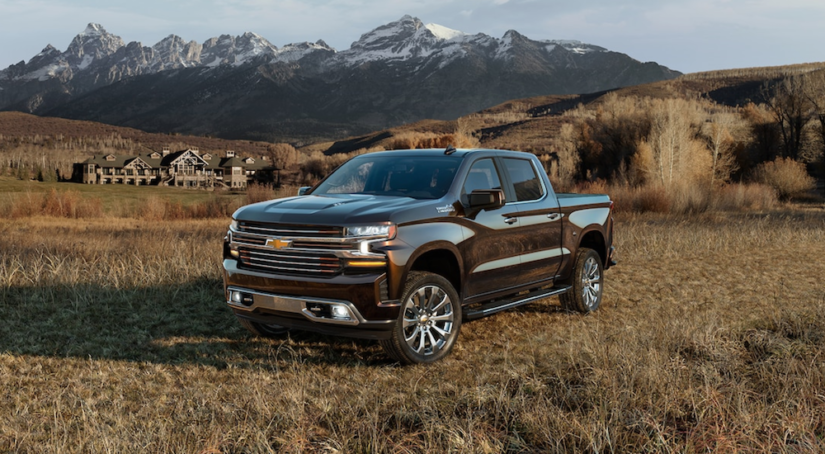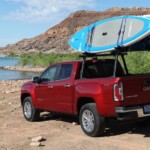What makes a great truck? Some may say power, towing, or off-road ability. Others may value tech, luxury, and comfort over brawn and capability. For most consumers, the correct answer is probably somewhere in the middle. The modern truck buyer expects a vehicle that is as comfortable towing a boat as it is pulling up the valet stand at a steak house. The modern truck should offer work with refinement and the chance to relax in a plush cabin after a hard day’s work. When looking for this combination, many consumers will come down to a choice of 2019 Chevy Silverado vs 2019 Toyota Tundra. One is an American classic; the other is the sales leader among foreign trucks. Let’s take a look at the facts and figures to see which truck you should be driving off the dealership lot.
A Nation of Trucks
There are few things more central to Americana than a full-sized pickup truck. Although perhaps not as iconic as football or apple pie, the truck holds a special place in the lore of the United States. It’s a symbol of the freedom and wide-open space that seems uniquely American. And boy do Americans love trucks. While the current SUV boom is getting all of the attention, there are more pickups sitting in driveways and garages than ever before. In fact, in 2018, US pickup sales already passed the 2-million-unit mark by September. Things haven’t shown any signs of stopping, either. First quarter sales were full 30% higher than the same period in 2014, according to Edmunds.
There are currently six different full-size trucks for sale and seven mid-size trucks. The wide selection and increased competition have been great for consumers. Quality has never been higher, but the same can be true for prices as well. If anything, more trucks hitting the market should lead to more choice and more equitable pricing.
Know Your Truck
The Chevy Silverado was introduced in August 1998 as a 1999 model. Since then, the truck has gone through three full redesigns, with the latest coming for the 2019 model year. As of now, the Silverado comes in three different cab sizes with differing bed lengths:
- Regular (Single) cab with long bed (8’ 2”)
- Crew cab with short bed (5’ 8”)
- Crew cab with standard bed (6’ 6”)
- Double cab with standard bed (6’ 6”)
The single cab arrived a little late to the party, mainly due to popularity; in 2018 only 12% of GM truck sales were single cab models. When it comes to seating, the Silverado can fit five or six, depending on trim choice. Trucks are high-margin vehicles for most automakers, and the Silverado has been a winning ticket for Chevy. Since it debuted, Silverado sales consistently passed the 300,000/year mark. In 2018, nearly 600,000 were sold, good for second out of all vehicles in the US.
Toyota has offered trucks for decades but didn’t release a vehicle capable of taking on the big boys until 1999. The Tundra premiered as a 2000 model and has grown into its role as a serious contender to the Silverado and Ford F-150. It received its last full redesign in 2014. The Tundra offers two cab options and three different bed lengths:
- Double cab with 5.5, 6.5, or 8.1-foot options
- Crew cab with 5.5 and 6.5-foot options
The Tundra can seat five or six passengers, with the base SR and SR5 offering first and second-row bench seating. The Tundra will probably never come close to the Silverado in terms of sales, but Toyota doesn’t depend on the truck like it does the Corolla or Camry sedans. Sales have been healthy for years, passing the 100,000 units/year mark from 2012 forward.
Power
Power is the name of the game when it comes to full-size trucks; there’s a reason almost every truck advertisement shows the pick-up pulling a boat or construction equipment. However, the anatomy of power has changed over the years. Buyers now expect a combination of power and fuel economy—drivers want the ability offered by a large engine without the traditional thirst associated with a large vehicle. Automakers have responded with both smaller engines and smarter V8s. Even when at work, a modern truck should hover around at least 15 MPG.

The Silverado comes with five engine choices, with a diesel on the horizon:
- 4.3-liter EcoTec3 V6 Engine – 285 horsepower
- 2.7-liter Turbo Engine – 310 horsepower
- 5.3-liter EcoTec3 V8 Engine – 355 horsepower
- 5.3-liter EcoTec3 V8 Engine with dynamic fuel management – 355 horsepower
- 6.2-liter EcoTec3 V8 Engine – 420 horsepower
Those looking to tow often should go with the 6.2-liter V8, which can tow 12,500 pounds. Payload varies by engine choice and configuration; base payload clocks in at 1,745 pounds and 2,543 pounds tops the range.
The Tundra is decidedly more old school than the Silverado. 2014 was a different time in the truck world, and V6 engines or the possibility of a 4-cylinder mill powering a full-sized truck seemed outlandish. Therefore, the Tundra offers 2 V8s in two-wheel drive and four-wheel drive, which will impact towing capacity:
- 4.6-liter Aluminum i-Force V8 – 310 horsepower
- 5.7-liter Aluminum i-Force V8 – 381 horsepower
With the weaker V8 and two-wheel drive configuration, the Tundra will tow 6,400 pounds. That’s a long way off from the 5.7-liter V8 (4WD), which will tow 10,100 pounds. Payload doesn’t change much between the four engine options and range from 1,600 pounds to 1,660 pounds.
Fuel Efficiency
The Silverado, with its six different engines, offers a wide range of fuel efficiency. The 4-cylinder engine, perhaps unexpectedly, receives the best gas mileage, at 20 MPG city and 23 MPG highway. The most exciting and forward-looking engine of the group is the 5.3-liter V8 with DFM. DFM stands for dynamic fuel management, and it’s really something. Dynamic fuel management technology monitors accelerator input (up to 80 times per second) to decide which of the 17 different cylinder patterns will optimize power delivery and efficiency. The result is an engine that acts like a V8 for hard acceleration and towing but can use a few at two cylinders when all eight aren’t needed. It easy to see how this technology could be adapted to the entire Chevy line-up.
The Tundra can’t keep up with the Silverado—it’s older V8s weren’t designed for maximum fuel economy. The smaller V8 will get 15 MPG city and 19 MPG highway. For the 5.7-liter V8, those numbers drop to 13 and 18, respectively. When it comes to fuel efficiency, options matter. The Silverado simply has too many smaller engines for the Tundra to keep up.
Price and Warranties
Watch enough game shows and you might notice something interesting. There are a lot of new cars being given out as prizes, but you’ll never see a truck being offered to the winner. This discrepancy is largely a function of cost—any new truck will set you back a pretty penny. Budget-conscious buyers may want to cover their eyes or search used trucks prices instead.
Both trucks cover a wide range of price points. The Silverado beats the Tundra on the low end, with a basic Silverado coming in at $28,300 while a Tundra SR double cab is offered for $31,420. At the other end of the price spectrum, these two trucks begin to separate from each other. A fully-loaded Tundra Platinum reserve will set you back around $53,500; a well-optioned Silverado High Country can reach up to $72,000. It’s a challenge to choose a winner here when the Tundra only offers V8 engines. Although the Silverado beats the Tundra’s base price, the Toyota may offer cheaper entry to the V8 market. Shoppers deciding between these two trucks should decide what matters the most to them before hitting dealership lots.
If you were depending on warranties to help you choose between these two trucks, you’re out of luck. Owners of both the Silverado and Tundra can get 3 years/36,000 miles basic and 5 years/60,000 miles powertrain.
The Results
Buying a new car is a personal decision that should only be done after careful research. The majority of Silverado and Tundra’s on dealer lots will be well over $30,000. You should take your time when making such a large purchase. We don’t want to push you towards a certain vehicle and intend for this comparison to merely serve as a helpful guide. Both of these trucks are well-made and don’t often let their owners down. However, based on the attributes examined here, the Silverado is the better truck. It’s combination of body styles, power, fuel efficiency, and price make it the clear winner.



